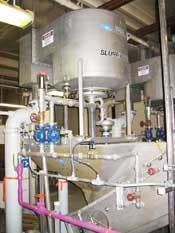Vortex Separators Provide Various Options in Grit Removal
by Robert Y.G. Andoh
Grit is a constant problem for wastewater treatment plants in many municipalities. It grinds away at mechanical equipment and accumulates in conduits and process chambers causing capacity and operational problems. Grit accumulation in primary and secondary process basins reduces a plant's treatment capacity, diminishes performance and increases operational maintenance costs.
Hydro International recently acquired Eutek Systems, a company that specializes in grit separation equipment. The company's vortex separator systems will be on display at WEFTEC in the Hydro International booth.
Grit removal chambers and technologies have evolved over the past several decades from the use of detritus tanks and constant velocity channels to the use of vortex chambers. Vortex systems use centrifugal and other rotational forces to assist gravitational forces in the separation of grit from organics and liquids. Consequently, a smaller footprint can be used to achieve equivalent or better treatment goals.
Vortex separators can be broadly classified as either mechanical vortex grit removal systems or induced vortex separators. The induced vortex separators rely to varying extents on a tangential intake to induce vortex motion, gravity and boundary layer effects to separate solids from liquids and unique geometric arrangements of internal flow modifying components.
Vortex chambers that rely solely on hydraulics without a need for power or mechanical equipment have the added advantage of further reducing operational and maintenance costs over the life of the system.
The different types of vortex grit removal devices offer targeted solutions for certain grit removal situations and duties and are typically characterized by a combination of headloss and grit capture efficacy.
High Headloss: Hydro cyclones are examples of high-headloss vortex separators. These separators rely on a tangential feed to generate high centrifugal forces and a free vortex type flow regime within a circular chamber that leads to effective solids liquid separation and classification. The TeaCup™ and SlurryCup™ from Hydro International are two examples. They use boundary layer effects to enhance classification, have no moving parts and can remove very fine grit in the sub 106 micron range. The irrecoverable head-losses across these types of vortex separators are significantly higher than the other two types of vortex separators, typically being in the 3- to 10-foot range, though for some cyclones, head losses can exceed 20 feet.
Medium Headloss: Medium-headloss vortex separators have irrecoverable losses in the 4 – 12 inch range and can maintain grit removal efficiency over a wide range of flow rates. These devices are typically used to remove grit particles with diameters in the 106 – 150 microns range. The Grit King® Separator is an example of such a device. The Grit King has no moving parts and uses a tangential feed to induce rotary motion within a circular chamber. The rotary flow patterns are stabilized by flow modifying members within the vessel to ensure long flow paths and virtually no short circuiting. This type of system is suited to upstream applications – ahead of fine screens, upstream of equalization basins, at satellite treatment sites within collection systems and upstream of drop structures into deep tunnels.
The HeadCell™ is another type of non-mechanical medium-headloss vortex separator which uses a high-efficiency flow distribution header to evenly distribute influent over multiple stacked conical trays. The tangential feed establishes a vortex flow pattern where solids settle into a boundary layer on each tray, and are swept down to a centrally located underflow collection chamber. Efficiencies are enhanced due to the large surface area and short settling distances (stacked tray clarification). Evenly splitting flows to multiple trays eliminates thermal short circuiting which reduces the performance of conventional grit basins. The system particularly lends itself to being retrofitted into existing chambers (e.g. aerated grit chambers) providing scope for significant cost savings on treatment plant upgrade projects.
Low Headloss: The low-headloss vortex separators often referred to as the Pista-type grit removal system, are devices with irrecoverable head losses typically being less than 4 inches. They rely on a mechanically induced forced vortex type flow pattern in shallow cylindrical chambers with relatively short detention time to capture grit solids in a central hopper. The mechanical moving parts are usually in the form of a turning paddle. Such systems tend to be used at wastewater treatment facilities where the treatment objective is to remove relatively coarse grit down to 300 microns in diameter.
The key to choosing an optimized grit removal system is to know the gradation of grit for the locality as well as the average daily flow and the peak wet weather flow for the treatment plant. Economics are always a factor for municipalities and regional wastewater treatment plants, so plant operators are increasingly cognizant of their options. Mechanically or Induced, Low-, Medium- and High-headloss vortex systems offer different capabilities and efficiencies in the removal of coarse to very fine grit.
About the Author:
Robert Y.G. Andoh is the director of innovation for Hydro International. He has authored and presented a significant volume of technical papers relating to urban flooding, collection systems and wastewater treatment processes, contributing extensively, on both a national and international basis, at communication events in the field of urban water management. He has served as a visiting professor of Liverpool John Moores University and a member of the Technical Advisory Board for the University of New Hampshire Stormwater Center.



